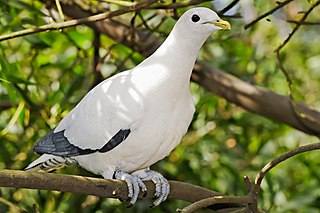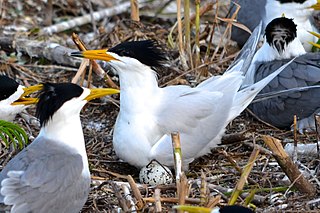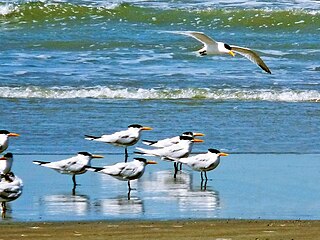
The Brook Islands National Park is a national park in Cassowary Coast Region, Queensland, Australia, 1246 km northwest of Brisbane, with an area of 0.9 km2. It was established in 1994 and comprises three islands which lie off the coast 7 km north-east of Cape Richards on Hinchinbrook Island and 30 km east of the nearest mainland town of Cardwell. The fourth island of the Brooks group, South Island, is not part of the national park but is protected by the Great Barrier Reef Marine Park Authority. Public access to the three islands in the national park is prohibited in order to protect breeding birds, especially the Torresian imperial-pigeon. The islands have no roads, walking tracks or other facilities. Popular activities in the waters around the islands are boating, snorkelling and fishing. The islands are managed by the Queensland Parks and Wildlife Service. The Park's IUCN category is II.

Michaelmas and Upolu Cays is a national park in Queensland, Australia, 1,409 km (876 mi) northwest of Brisbane and 33 km (21 mi) east of Cairns. It comprises two small cays on Michaelmas Reef, which forms the north-eastern section of the Arlington reef complex, within the Great Barrier Reef.
Swain Reefs is a national park in North Queensland, Australia, 703 km (437 mi) north of Brisbane. It was established in 1995, and covers an area of 0.58 km2. It is managed by the Queensland Parks and Wildlife Service.

The Farne Islands are a group of islands off the coast of Northumberland, England. The group has between 15 and 20 islands depending on the level of the tide. They form an archipelago, divided into the Inner Group and the Outer Group. The main islands in the Inner Group are Inner Farne, Knoxes Reef, the East and West Wideopens, and the Megstone; the main islands in the Outer Group are Staple Island, Brownsman, North and South Wamses, Big Harcar, and Longstone. The two groups are separated by Staple Sound. The highest point, on Inner Farne, is 62 feet (19 m) above mean sea level.

Terns are seabirds in the family Laridae that have a worldwide distribution and are normally found near the sea, rivers, or wetlands. Terns are treated as a subgroup of the family Laridae which includes gulls and skimmers and consists of eleven genera. They are slender, lightly built birds with long, forked tails, narrow wings, long bills, and relatively short legs. Most species are pale grey above and white below, with a contrasting black cap to the head, but the marsh terns, the Inca tern, and some noddies have dark plumage for at least part of the year. The sexes are identical in appearance, but young birds are readily distinguishable from adults. Terns have a non-breeding plumage, which usually involves a white forehead and much-reduced black cap.

The Sandwich tern is a tern in the family Laridae. It is very closely related to the lesser crested tern, Chinese crested tern, Cabot's tern, and elegant tern and has been known to interbreed with the lesser crested. It breeds in the Palearctic from Europe to the Caspian Sea wintering to South Africa, India and Sri Lanka.

The roseate tern is a species of tern in the family Laridae. The genus name Sterna is derived from Old English "stearn", "tern", and the specific dougallii refers to Scottish physician and collector Dr Peter McDougall (1777–1814). "Roseate" refers to the bird's pink breast in breeding plumage.

The lesser crested tern is a tern in the family Laridae.

The elegant tern is a tern in the family Laridae. It breeds on the Pacific coasts of the southern United States and Mexico and winters south to Peru, Ecuador and Chile.

The Chinese crested tern is a tern in the family Laridae. It is the county bird of Lienchiang County, Fuchien.

The greater crested tern, also called crested tern or swift tern, is a tern in the family Laridae that nests in dense colonies on coastlines and islands in the tropical and subtropical Old World. Its five subspecies breed in the area from South Africa around the Indian Ocean to the central Pacific and Australia, all populations dispersing widely from the breeding range after nesting. This large tern is closely related to the royal and lesser crested terns, but can be distinguished by its size and bill colour.
Orange-billed tern is a name applied to a group of three large terns in the genus Thalasseus with orange bills, which are quite similar in appearance and often considered difficult to identify, namely:

Thalasseus, the crested terns, is a genus of eight species of terns in the family Laridae.

Mohawk Island is a small island in the northeast of Lake Erie, in Haldimand County, Ontario, Canada. It is composed of limestone with almost no vegetation, and is close to the water level. It was formerly known as Gull Island and contains the ruins of the Gull Island Lighthouse which was built in 1848 to guide ships into the Welland Canal at Port Maitland. In 1933, the lighthouse was automated to no longer require a human keeper and lost significance in 1934 due to the realignment of the canal at Port Colborne. It was decommissioned in 1969 when the mechanism was destroyed by a fire. The lighthouse is located close to the shore of Rock Point Provincial Park.

The Low Islets, part of the Passage Group within the Furneaux Group, is a close pair of unpopulated small granite islands with a combined area of 2 hectares, located in Bass Strait, south of Cape Barren Island, and west of both Spike and Clarke islands, in Tasmania, in south-eastern Australia.

Briggs Islet is a small granite island, with an area of 3.4 ha, in south-eastern Australia. It is part of Tasmania’s Great Dog Island Group, lying in eastern Bass Strait between Flinders and Cape Barren Islands in the Furneaux Group. It is a conservation area. The island is part of the Franklin Sound Islands Important Bird Area, identified as such by BirdLife International because it holds over 1% of the world populations of six bird species.

The Governor Island, part of the Schouten Island Group, comprise two small granite islands with a combined area of about 2 hectares that lie close to the eastern coast of Tasmania, in south-eastern Australia. The island is located near the Freycinet Peninsula and the town of Bicheno and is a nature reserve.
The Cartier Island Marine Park is an Australian marine park that covers the Cartier Island and reef surrounds, about 610 km (380 mi) north of Broome, Western Australia. The marine park covers an area of 172 km2 (66 sq mi) and is assigned IUCN category Ia. It is one of the 13 parks managed under the North-west Marine Parks Network.

Cook Island Nature Reserve is a protected area in the Australian state of new South Wales located on Cook Island about 600 metres (2,000 ft) off the coastline from the headland of Fingal Head and about 4 kilometres (2.5 mi) south-east of Tweed Heads on the state's north coast.

The West African crested tern is a bird species in the family Laridae. Until 2020 it was considered a subspecies of the New World royal tern, Thalasseus maximus.
















